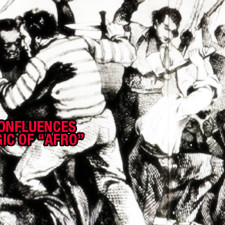What exactly is it about the Great Migration of black southerners to Chicago (1910-1940) that spells modernity? Often the answer to this question gets bundled up with the notion of ‘modernism’—a word that serves as an irksome shorthand for the common traits of cultural and artistic phenomena of the first half (or quarter, or three quarters) of the twentieth century. The urban destinations of black travels, with their alienating rhythms, factories and anonymous crowds, are thus seen—and rightly so—as the breeding ground for a black modernist consciousness.
But before modernism there was modernity, and modernity—a word ubiquitously used in reference to the most disparate historical moments—is fundamentally characterized by one trait: an intensified self-consciousness. A large group of people bound by a particular combination ethnicity, class, geography, gender or artistic agenda becomes modern the moment they take a deliberate group action. For Afro-Americans the migration embodies such an action. No wonder, either, that their modern moment should take the form of deliberate mass travel: the cradle of Afro-American history was the single most horrifying mass deportation in world history. One can hardly think of a group to who planned and deliberate re-location could hold greater significance.
Of course, it is not the case that the millions of migrants thought of themselves as re-claiming control over their geographical location; part of the significance of the migration has been attributed to it with hindsight. Yet the imagery of the move to a better place—not the longing for the peaceful afterlife that haunts the spirituals, but the actual fantasy of travel itself—haunts countless of the songs of the genre that marks the seam between the southern peasant labour and the first beginnings of the urban struggle: the Delta Blues.
Delta Blues has a special link to Chicago as many of its foremost artists migrated there as well as to Detroit. Among the migrants headed to the Windy City stand, most famously, Big Joe Williams, Robert Johnson, Bukka White and the legendary Muddy Waters. Talking about the attribution of historical significance in hindsight, the Delta Blues has the narrative of origin—as the rural beginnings of the blues tradition, but also of country music, bluegrass and as the matrix idiom of the brit rock of the 60s—pinned all over it. It is thus almost ironic that the Delta Blues should be a genre about transition.
Indeed one of the themes that haunt Delta Blues songs is travel, and particularly the train. A gentleman by the name of Wes Modes has compiled a list of train songs, which is fascinating to peruse and is available on Wikipedia. Many of these songs are from Delta Blues artists—a few samples are “All Aboard,” by Muddy Waters and “Black Train Blues” of Bukka White and Lonnie Johnson’s “Long Black Train.” One of the most famous and widely covered train songs ever written, “Love in Vain,” most famously by the Rolling Stones in 1972 was written and sung by Delta Bluesman Robert Johnson.
The imagery of the train becomes, in a song like ‘Love in Vain’, the very image of distance, as both the imminent geographical distance of the departing beloved woman, and also the sentimental distance of the lover who chooses to leave. A potent image to migrants such as the train became the way to sing about love, women, and loss, and through this allegory it travelled through the guitars and voices of musicians that are continents and generations apart from its original impulse. Sung by these southern bluesmen, the great migration and the stories of those who lived it leave their trace as they keep, well, migrating.
DC
Tags: Black History Month, Chicago, slavery, The Blues, The Chicago Project, The Delta Blues, The Rolling Stones

 Share On Facebook
Share On Facebook Tweet It
Tweet It






